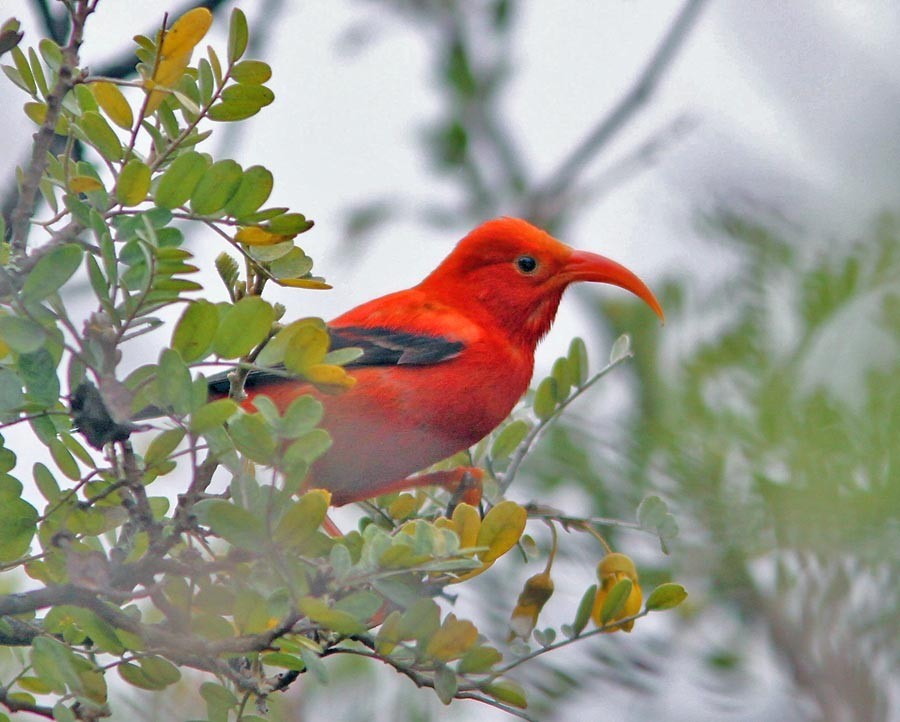Iiwi
A species of Vestiaria Scientific name : Drepanis coccinea Genus : Vestiaria
Iiwi, A species of Vestiaria
Botanical name: Drepanis coccinea
Genus: Vestiaria
Content
Description General Info
 Photo By Don Roberson
Photo By Don Roberson Description
The adult ʻiʻiwi is mostly scarlet, with black wings and tail and a long, curved, salmon-colored bill used primarily for drinking nectar. The contrast of the red and black plumage with surrounding green foliage makes the ʻiʻiwi one of Hawaiʻi's most easily seen native birds. Younger birds have golden plumage with more spots and ivory bills and were mistaken for a different species by early naturalists. Observations of young birds moulting into adult plumage resolved this confusion. Along with the Hawaiʻi Mamo, ʻiʻiwi were used in the feather trade. The ʻiʻiwi's feathers were highly prized by Hawaiian aliʻi (nobility) for use in decorating ʻahuʻula (feather cloaks) and mahiole (feathered helmets), and such uses gave the species its original scientific name: Vestiaria, which comes from the Latin for "clothing", and coccinea meaning "scarlet-colored". (In 2015 the IOC World Bird List moved the ʻiʻiwi from genus Vestiaria to Drepanis because of the close relationship between the ʻiʻiwi and the two species of mamo; Drepanis comes from the Greek for sickle, a reference to the shape of the beak.) The bird is often mentioned in Hawaiian folklore. The Hawaiian song "Sweet Lei Mamo" includes the line "The ʻiʻiwi bird, too, is a friend". 
Size
13 - 23 cm
Feeding Habits
The long bill of the ʻiʻiwi assists it to extract nectar from the flowers of the Hawaiian lobelioids, which have decurved corollas. Starting in 1902 the lobelioid population declined dramatically, and the ʻiʻiwi shifted to nectar from the blossoms of ʻōhiʻa lehua (Metrosideros polymorpha) trees. ʻIʻiwi also eat small arthropods. 
General Info
Distribution Area
The largest populations of ʻiʻiwi inhabit Hawaiʻi Island, followed by Maui with the greatest numbers in East Maui, and fewer than 1% of ʻiʻiwi remain on Kauaʻi. There may be remnant populations on Molokaʻi and Oʻahu; very few ʻiʻiwi have been recorded on either island since the 1990s. They are no longer present on Lānaʻi. Overall, ninety percent of the ʻiʻiwi population is confined to a narrow band of forest on East Maui and the windward slopes of the island of Hawaii, between 4,265 and 6,234 feet (1,300 and 1,900 meters) in elevation. They are most abundant in mesic to wet forests at higher elevations. These birds are altitudinal migrants; they follow the progress of flowers as they develop at increasing altitudes throughout the year. It has also been noted that birds on Mauna Kea, Hawaiʻi Island, likely make daily trips from lower elevations to feed on nectar. Seeking food at low elevation exposes them to low elevation disease organisms and high mortality. It has been theorized that the ʻiʻiwi can migrate between islands and it may be why the bird has not gone extinct on smaller islands such as Molokaʻi. Altitudinal migration complicates population assessment. 
Species Status
ʻIʻiwi was formerly classified as a near threatened species by the IUCN, but recent research has proven that it is rarer than previously believed. Consequently, it was uplisted to vulnerable status in 2008. The species was listed as threatened by the United States Department of the Interior on 20 October 2017. ʻIʻiwi are listed as a threatened species because of small and declining populations in some of its range and its susceptibility to fowlpox and avian malaria. Avian malaria (Plasmodium relictum) is an introduced disease that is spread by mosquitoes. ʻIʻiwi generally survive at higher elevations where temperatures are too cool for mosquitoes. Many disease-susceptible endemic birds, including ʻiʻiwi and kiwikiu, became rare to absent at lower elevations, even in relatively intact native forest. In a laboratory study, ninety percent of all ʻiʻiwi exposed to avian malaria died and the other ten percent were weakened but survived. Avian malaria has been identified as the primary driver of declines in abundance and distribution of ʻiʻiwi observed since 1900. ʻIʻiwi habitat has been reduced and fragmented through various types of land development, including clearing native forest for food crops and grazing. Invasive plants also outcompete and displace native plants that ʻiʻiwi use for foraging and nesting. Invasive animals impact ʻiʻiwi in a variety of ways, for example feral ungulates may trample native plants and spread nonnative plants and invasive seeds, further degrading habitat. Feral pigs often create wallows by knocking over vegetation and hollowing out areas that fill with rain water. These have the potential to become incubator sites for mosquito larvae, which in turn spread avian malaria. Organizations throughout the islands have established nature reserves to protect native habitat. Fencing off sections of land to keep out feral ungulates, especially pigs, goats and axis deer enables native plants to recover from overgrazing and ungulate damage and helps restore native bird habitat. In recent years another threat has put native bird habitat at risk. Conservation groups are diligently working to reduce the risk of spreading a disease called Rapid Ohia Death (ROD). This disease along with ʻōhiʻa dieback and ʻōhiʻa rust could lead to a rapid decline in ʻōhiʻa forests, an important nectar source for ʻiʻiwi. 